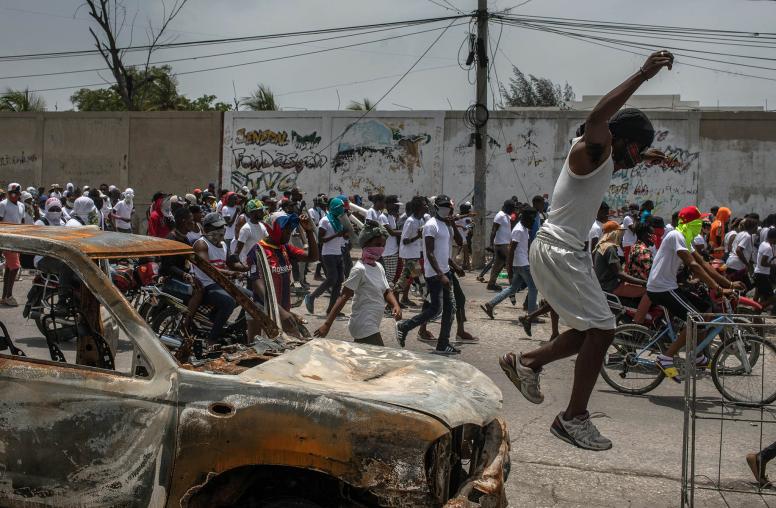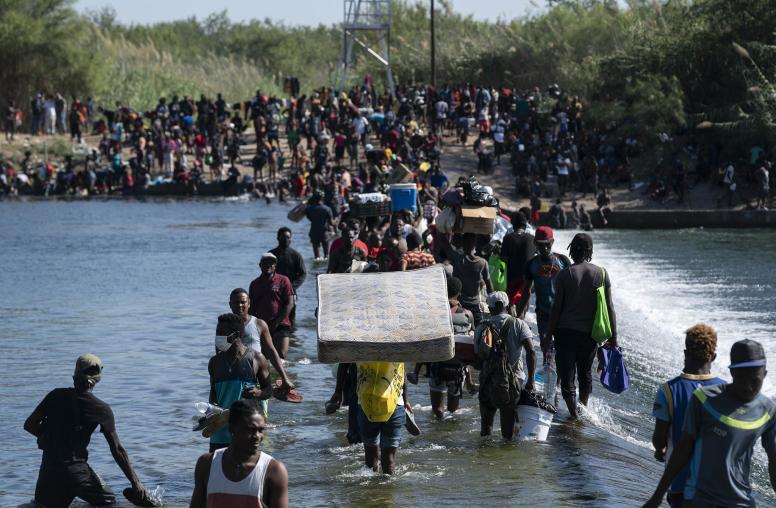A Plan for Haiti’s Growing Fragility: U.N. Action That’s Equal to the Challenge
Only a new international mission can help stabilize the Caribbean nation in its current, intractable state.
When throngs of Haitian migrants rushed the U.S. border recently, it was only the latest manifestation of a society battered by trauma. In just the previous two months, Haiti had seen the murky assassination of its president, devastating floods and an earthquake that killed thousands and wiped out nearly 140,000 homes. As fragile states go, Haiti is in a league all its own. To avoid a repetition of the scene at the border — or one that’s worse throughout the hemisphere — it is time to consider a long-term, robust U.N. mission that matches the scale of the challenge with the size and persistence of the international response.

There are clear historical, cultural and climatic reasons for Haiti’s unique status. Combined, they have left the country over the past quarter century reliant — to varying degrees — on the international community for security, development and governing support. Even with that assistance, Haiti struggles. When it’s withdrawn, poverty turns to famine, insecurity to widespread murder and political in-fighting to coups, leaving the country wholly unprepared for the inevitable climate disasters to come.
The international response in Haiti has rarely been matched to the country’s reality, often focusing on a purely humanitarian agenda when the real issue was political. Efforts have scaled up and down depending on the emphasis of donors, not the long-term needs of Haitians. What’s needed now is a U.N. mission equal to the challenge that Haiti presents.
For all the baggage that it still carries in Haiti, and despite its flaws, the United Nations is the only entity that over the long-term can deal with the complex nature of the Haitian crisis. Until now, international assistance has been parsed with the goal of avoiding extended involvement in fragile states and setting a clear “graduation date” where international assistance would no longer be needed. Acceptance of the requirement for a longer-term, sustainable mission could finally put Haiti on a trajectory to stability and establish a precedent for other similar “unique” cases.
What Makes Haiti Uniquely Fragile?
The Haitian people, one observer said after the restoration of democracy in the mid-1990s, “are suffering with hope.” The new government at the time had ended a century of cruel and incompetent dictators and garnered the full, if impatient, support of the international community, which finally reversed its long-standing position of neglect.
But Haiti was never going to be a conventional democratic transition. Its history, culture, geography and isolation all conspired against positive change.
Jim Dobbins, former special envoy for Haiti under President Clinton, points out that Haiti is a very “introverted” society, excluded from the family of nations for more than 50 years after its independence in the early 19th century and, even after that, not fitting comfortably in either the Spanish or English Caribbean.
Haiti’s leaders, professor Phillipe Gerard points out, took a country of immense natural and human resources and led it to the point of exhaustion through a “worst case scenario of continuous misrule,” marked by “corruption, instability, and xenophobia.”
Other social and political actors were either unwilling or unable to fill the gap. Haiti lacks “a coherent political class and a sense of national consensus about the basics of governance,” Dobbins said. The brutality of Haiti’s governing elites crushed any chance for the development of civil society and education consistently lagged — a tragedy given the value the Haitian people place on learning.
Historical Institutional Weakness
These deficits led to consistently weak institutions. In some areas, such as justice, it was an impossibly complex system inherited from the French. Haiti’s constitution was developed through political bargains that produced a document that generated more conflict than consensus. The security forces were also rendered weak and dysfunctional by the democratizing government’s early decisions to limit their capacity in reaction to former abuses. The potential agents of order had difficulty establishing a monopoly on the use of force, leading to persistent and often debilitating violence and instability.
Added to this challenging political environment, Haiti largely missed the industrial revolution, focusing instead on agriculture; what little industry it had in the 1970s was driven away by U.S. sanctions during the wave of globalization and never returned. To make matters worse, Haiti is extremely prone to earthquakes, sitting on two tectonic plates, and is regularly in the path of devastating tropical storms. Its deforested landscape and poor-quality construction make the impact of both worse than many of its neighbors.
The Ups and Downs of an International Response
The international community has been both persistent and inconsistent in its response to the ongoing Haiti crisis. Since 1993, Haiti has had a U.N. peacekeeping mission, starting as a robust mission designed to re-establish order and build new institutions, and going through various ups and downs in force strength, mandate and even basic utility.
The Security Council established the U.N. Mission in Haiti (UNMIH) in 1993 to ensure the implementation of an accord between the country’s military regime and democratic forces. That effort followed three years of U.N. and at times, joint U.N./OAS observer and dialogue support missions initiated after the departure of dictator Jean-Claude Duvalier and the 1991 coup against democratically elected Jean Bertrand Aristide.
The Deployment of U.N. Forces
It took two years and a U.S.-led military intervention to create the conditions for the deployment of the U.N. forces, which initially included 6,000 troops and 800 international civilian police. The mission oversaw the training and equipping of a new police force, disarmament and demobilization of the armed forces and accompanied the election of a new president with a peaceful transfer of power.
The U.N. mission transitioned through various phases between 1994 and 2001 until all civilian police advisors and peacekeeping troops were withdrawn and only a small political and humanitarian mission remained. Haiti soon entered a period of political chaos and disarray in the security forces, accompanied by the rise of politically active gangs.
Stabilizing Mission
By 2004, near-civil-war conditions forced President Aristide to step down, and interim President Boniface Alexandre quickly sought the U.N.’s help to create sufficient stability to hold elections. After a three-month intervention by an interim force, the U.N. Stabilization Mission in Haiti (MINUSTAH) deployed an initial 8,000-strong force composed of police and military components that later grew to a 13,000-person combined force following the catastrophic 2010 earthquake.
The mission, lasting more than 13 years, was plagued by scandal including incidents of sexual predation by peacekeepers and a deadly cholera epidemic traced back to the Nepalese contingent. But it also achieved significant milestones in police reform, demobilization of armed groups and establishment of basic security, reconstruction following the 2010 earthquake, and the restoration of constitutional order in 2016 with parliamentary elections and the peaceful appointment of a president.
Despite the key role experts believed MINUSTAH played in maintaining basic stability in Haiti, the United States forced a withdrawal of the military contingent in 2017 and the police contingent in 2019 as part of a global effort to reduce the cost of peacekeeping operations. The U.N. mission has now shrunk to the U.N. Integrated Office in Haiti, which has none of the active components the country needs to sustain a secure and stable environment.
Time to Accept a Long-Term, Capable U.N. Presence
U.N. efforts in Haiti have always suffered from the view that the country could follow the conventional model of transitions in Eastern Europe, Central America and the Southern Cone. There, democracy followed an often-temporary polarization and a sharp end to an insurgency or dictatorship. But absent key institutions and a functional political elite, Haiti was always going to go through a more lethargic, personalist, halting transition in which force would inevitably be part of the political dialogue. The necessity is that destructive internal force be countered by a long-term, stabilizing external one.
Rather than conventional peacekeeping, truce supervision could be a more apt model to apply to Haiti — missions such as the U.N. Truce Supervision Organization in the Middle East that has been active since 1948 or the continuing Military Observer Group in India and Pakistan established in 1949. These missions settled in early for a long stay. A closer model could be the U.N. Administration Mission in Kosovo, which since 1999 has promoted stability, security and respect for human rights in a similarly challenging political and regional environment in light of Kosovo’s unsettled status.
Such a mission in Haiti would necessarily include a small military contingent, a large civilian police mission, justice sector assistance and strong and dynamic support for the political process including national dialogue, reconciliation, free and fair elections and governance.
If properly led and managed, it would not need to be intrusive in the lives of Haitians; rather, it would improve the lives of many now fleeing by establishing security and functioning government institutions. It would be by far the cheapest, most humane and most effective way to provide the support the Haitian people need and could finally pave the way for the long-term political and social stability that has eluded the country for decades.

